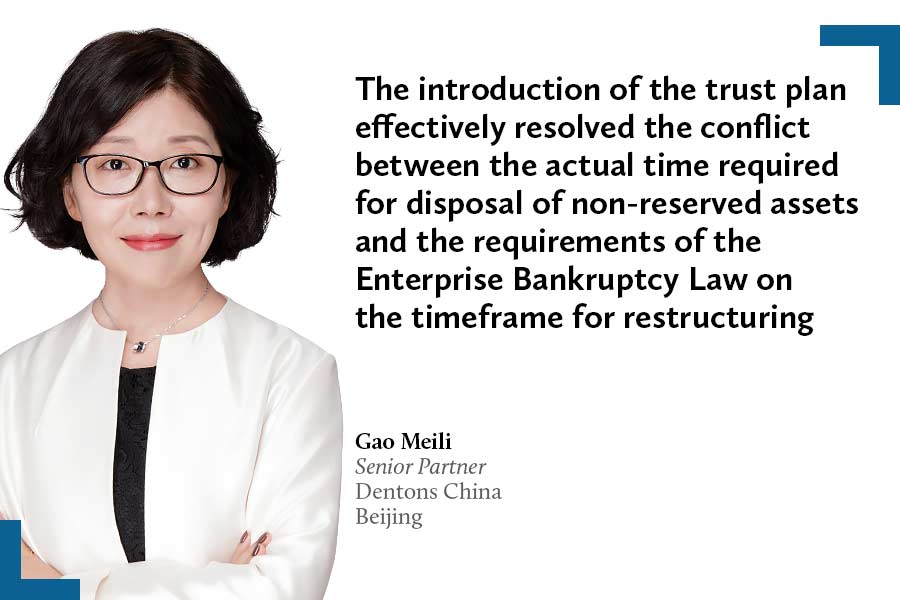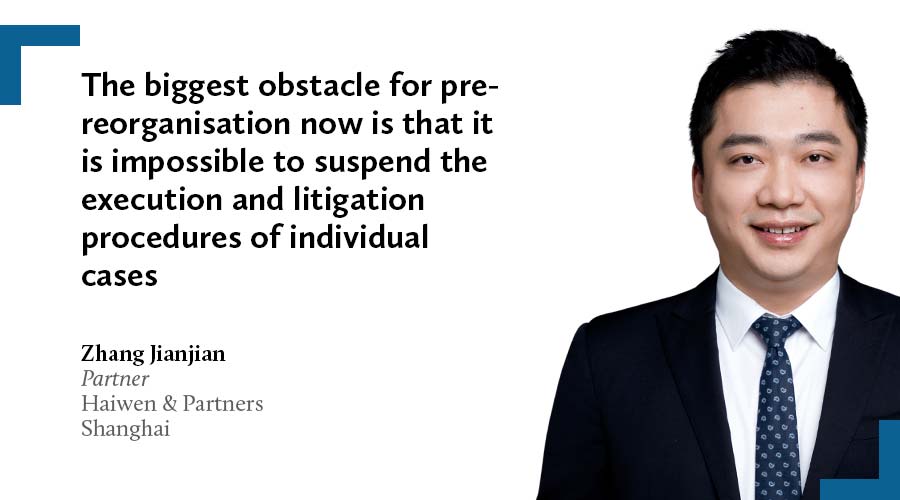Misunderstood by many, the bankruptcy regime in China requires urgent legislative and administrative upgrades to inject market logic into the economy. As Luna Jin reports, meaningful endeavours are being made to revitalise businesses
Compared with developed markets such as the US, with its modern bankruptcy law based on 130 years of history, China faces the duality of an infant bankruptcy mechanism and a complicated economic reality, where a growing number of business entities are in dire need of an exit.
The brief history of China’s bankruptcy law is very much intertwined and in step with the country’s social reform since 1978. The top legislature set out to make the Enterprise Bankruptcy Law almost simultaneously with the country’s opening up, but only in 2007 did the law officially come into effect at a time when China’s market took in more diversified players, with some naturally descending into zombie enterprises under increasingly intensified competition.
Negative perceptions of the idea of bankruptcies are still common in China. After all, society has only moved onto the notion in a little more than 10 years, while in the recent past there was simply no need for putting any socialist enterprise to an end.
Quite often, local governments harbour a bias against corporate insolvency, and will even block the bankruptcy process of big state-owned companies to promote the idea of growth and keep a nice employment rate. Debtors are reluctant to file for bankruptcy for fear of being held accountable for operating irregularities, and make do with the cheaper liquidation process, while creditors each want a share of the proceeds first through their individual enforcement proceedings.
However, the table is turning as parties have witnessed successful restructurings of conglomerates in recent years, including HNA Group, Founder Group and Tsinghua Unigroup, testament to how the bankruptcy reorganisation procedure not only removes zombie companies but also serves as a constructive rescue to distressed businesses.
In the midst of change, the professional community of lawyers, accountants, bankruptcy judges and government officials are working together to bring investors, creditors and debtors to a consensus, and to formulate creative and ground-breaking schemes to pay creditors back.
Michelle Luo, a senior partner at Hui Ye Law Firm in Shanghai, observes that there has been a significant increase in the number of cases where companies have opted for bankruptcy restructuring on their own initiative, compared with past years.
Behind all the effort, fruitful explorations in different cities have developed effective, but still inconsistent, methods.
To provide a solid basis for practice, and to catch up with international norms, the need for filling in legislative gaps, and for supporting measures from various government departments, has become crucial.
INSTITUTIONAL CHANGE
The judicial system is gradually establishing specialised bankruptcy courts across the nation and drawing up different guidelines for bankruptcy practices, but these rules vary and are rarely harmonised.
The pre-reorganisation system, which bridges in-court and out-of-court procedures, is rapidly gaining traction in China and has played a valuable role in practice.
In October 2021, the State Council issued an opinion on pilot work regarding innovation in the business environment, mentioning the introduction of a pre-reorganisation system for bankruptcy in the first six pilot cities of Beijing, Shanghai, Chongqing, Hangzhou, Guangzhou and Shenzhen.
According to Gao Meili, a senior partner at Dentons China in Beijing, courts in different regions of at least 17 provinces and cities around the country have formulated 41 guidelines for pre-reorganisation to date.
However, the effectiveness of these local guidelines remains questionable. Due to a lack of uniform rules and regulations, “in practice there are even problems with pre-reorganisation being seen as a tool to extend the period of restructuring, as a testing ground for the official restructuring procedures, or as a through train for appointing administrators”, says Gao.
Luo says that, precisely because of the lack of a superior law, there are inconsistencies in the rules on pre-reorganisation in terms of: how to apply for one; the duration; the selection and renewal of administrators; the suspension of execution procedures during pre-reorganisation; the release of the measures for preserving the debtors’ assets during pre-reorganisation; the continuation of the voting mechanism and the effectiveness of voting; and the succession of creditors’ committees from pre-reorganisation to court proceedings.
Luo cites the Shanghai Bankruptcy Court’s version of a trial guideline for pre-reorganisation as an example. The conditions for applying for pre-reorganisation in the document are set mainly from the perspective of the development prospects of the industry to which the company belongs, the company’s internal governance and operations, and other aspects of the company’s capability to continue to operate, with the court mainly considering the value in the company’s reorganisation. By contrast, she says, “courts in some regions will also take social stability into account when setting the conditions for starting the pre-reorganisation”, noting the regulations of the Shenzhen and Nanjing courts.
On the question of whether the measures for preserving debtors’ assets can be released in pre-reorganisation, Luo says that some local courts have positive provisions while most courts only allow for the release of preservation within the jurisdiction of the city court.
In this regard, Zhang Jianjian, a Shanghai-based partner at Haiwen & Partners, suggests that China needs to adopt a bankruptcy protection mechanism as soon as possible, drawing on international experience to add such a mechanism prior to liquidation and restructuring, which also bridges to pre-reorganisation.
“The biggest obstacle for pre-reorganisation now is that it is impossible to suspend the execution and litigation procedures of individual cases, or suspend payment during pre-reorganisation, leading to poor results,” says Zhang.
It remains to be seen whether the expectations of the industry will eventually be incorporated into the law, as the Standing Committee of the National People’s Congress is currently further refining a draft amendment to the Enterprise Bankruptcy Law.
Changes are also needed at the administrative level. The handling of an insolvent company involves not only legal procedures, but also the resettlement of employees, disposal of land, plant and equipment, payment of taxes, credit repair, treatment of suspected crimes, and other issues involving social security, taxation, public security authorities, land and resources, housing and construction, and financial regulation. These require the co-ordination of various departments, so the intervention of administrative power is indispensable.
The government-court linkage mechanism, which aims to strengthen the synergy between government departments and the judiciary in related matters, is being rolled out nationwide.
Gao, of Dentons China, says that as the number of bankruptcy restructuring cases of listed companies increases, a dedicated supervision mechanism for these companies has been systematised, and securities regulators and the courts are becoming increasingly adept at working with each other.
In March 2022, the Shanghai and Shenzhen stock exchanges issued regulatory guidelines on bankruptcy restructuring matters, providing updated regulatory advice on information disclosure, suspension and resumption of trading, insider information and lockup periods in the bankruptcy proceedings of listed companies, clarifying practical issues that had previously been prevalent in the restructuring process.
In November, the Nanjing Intermediate People’s Court and the China Securities Regulatory Commission’s (CSRC) Jiangsu bureau jointly issued a notice that they would work together to strengthen their co-operation during the restructuring of listed companies and to enhance rescue effectiveness, the first collaborative mechanism in the country specifically for restructuring listed companies.
Leo Hou, a Beijing-based partner at Global Law Office, says that some cities conducting pilot projects on business environment innovation are also exploring positive measures such as: “Optimising the land and property disposal procedures of insolvent businesses; optimising the mechanism for unsealing and disposing of property in bankruptcy cases; and further facilitating the access of bankruptcy administrators to information on the property of insolvent businesses.”
You must be a
subscribersubscribersubscribersubscriber
to read this content, please
subscribesubscribesubscribesubscribe
today.
For group subscribers, please click here to access.
Interested in group subscription? Please contact us.






























